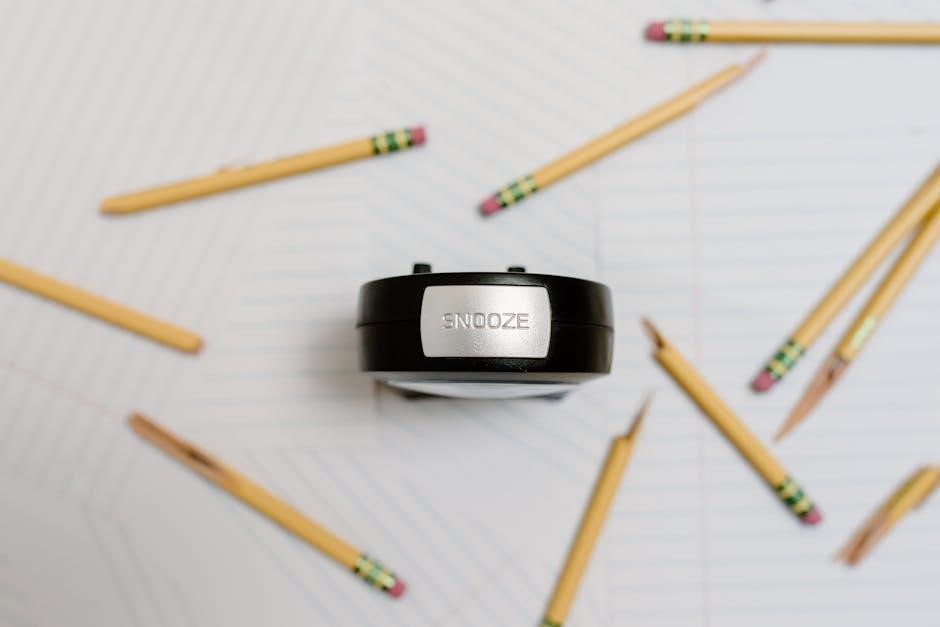iHome alarm clocks combine innovative features like Bluetooth connectivity, USB charging, and dual alarms with traditional functionality, offering a seamless blend of modern convenience and reliability.
1.1 Overview of iHome Alarm Clock Models
iHome offers a diverse range of alarm clock models, each designed to cater to different user preferences and needs. The iBT29 and iBT210 models are popular for their Bluetooth connectivity, allowing wireless music streaming. The iM29 stands out with its color-changing dual alarms and relaxing mood lights. Other models, like the iBT235, feature advanced options such as USB charging ports and speakerphone functionality. Each model combines sleek designs with practical features, ensuring a blend of style and functionality. Whether you prefer a basic alarm system or a feature-rich device, iHome provides a variety of options to enhance your daily routine.
1.2 Key Features of iHome Alarm Clocks

iHome alarm clocks are equipped with a variety of features designed to enhance user experience. Many models include Bluetooth connectivity, enabling wireless music streaming from smartphones or tablets. Dual alarm functionality allows users to set multiple wake-up times, perfect for shared spaces. Additional features such as USB charging ports provide convenient device charging. Some models also include FM radio capabilities, offering entertainment options. The snooze function and adjustable display settings ensure customization. These clocks often come with battery backup, maintaining time and alarms during power outages. Combining modern technology with essential alarm features, iHome clocks offer a practical and versatile solution for daily use.

Getting Started with Your iHome Alarm Clock
Unbox your iHome alarm clock, install batteries or connect to power, and follow the setup guide to configure basic settings like time, date, and alarms.
2.1 Unboxing and Initial Setup
Start by carefully unboxing your iHome alarm clock and inspecting the contents, which typically include the clock, a power adapter, batteries, and a user manual. Ensure all components are included and undamaged. Install the provided AA batteries or connect the clock to a power source using the included adapter. Place the clock on a stable surface, preferably near a power outlet. Turn on the device and follow the on-screen or manual instructions to set the initial time, date, and alarms. Familiarize yourself with the buttons and controls to navigate through settings seamlessly. This step ensures your clock is ready for daily use.
2.2 Connecting to Power and Installing Batteries
Connect your iHome alarm clock to a power source using the provided AC adapter, ensuring the plug is securely inserted into both the clock and the wall outlet. For battery installation, open the compartment located on the back or bottom of the device. Insert the recommended AA batteries, ensuring proper orientation as marked. Close the compartment tightly to secure the batteries. The clock will now maintain time and alarms even during power outages. Use alkaline batteries for longer life and avoid mixing old and new batteries. This setup ensures uninterrupted functionality and keeps your alarm clock ready for daily use.

Setting the Clock
Setting the clock on your iHome alarm clock involves pressing and holding the designated button until the display flashes, then adjusting the time using the +/- buttons for accurate settings.
3.1 Adjusting the Time and Date
To adjust the time and date on your iHome alarm clock, press and hold the designated button until the display flashes. Use the +/- buttons to set the correct time and date. Ensure the AM/PM indicator is accurate for your time setting. Once satisfied, press the button to confirm. The clock will automatically update and save your settings. Note that some models may require toggling between time and date modes during adjustment; Always refer to your specific model’s manual for exact steps, as slight variations may apply. Properly setting the time and date ensures accurate alarm functionality and optimal performance of your alarm clock.
3.2 Understanding AM/PM Indicators
The AM/PM indicators on your iHome alarm clock are crucial for accurate timekeeping. “AM” stands for Ante Meridiem (before noon), while “PM” stands for Post Meridiem (after noon). These indicators appear to the left of the display. When setting the time, ensure the correct AM/PM mode is selected to avoid scheduling alarms incorrectly. For example, setting an alarm for 7:00 AM instead of 7:00 PM could lead to missed wake-up times. Pay attention to the indicator during time adjustments to maintain proper scheduling. This feature ensures your alarm clock operates correctly, aligning with your daily routine and preferences for reliable wake-ups and notifications.
3.3 Daylight Savings Time Adjustment

Adjusting for Daylight Savings Time (DST) on your iHome alarm clock ensures your schedule stays accurate. Most models automatically update for DST, but if manual adjustment is needed, press and hold the clock or settings button until the time display flashes. Use the +/- buttons to adjust the time forward or backward by one hour. Ensure the AM/PM indicator reflects the correct time period. If your area does not observe DST, disable the automatic DST feature in the settings to prevent unwanted time changes. Always verify the time after DST transitions to maintain consistency with your daily routine and alarms.

Setting and Using Alarms

Set alarms using the Alarm Button, adjusting time with +/- buttons. Enable or disable alarms and use snooze for added convenience, ensuring timely wake-ups every day.
4.1 Creating and Editing Alarms
To create an alarm, press and hold the Alarm button until the display flashes and a beep sounds. Use the ⎯ or + buttons to set the desired time, holding for rapid adjustment. Ensure the correct AM/PM indicator is selected. Once set, the alarm icon will appear on the display. To edit an existing alarm, follow the same steps, adjusting the time as needed. You can also enable or disable alarms by pressing and holding the Alarm button until the alarm icon toggles on or off. This feature allows for multiple alarms, perfect for different wake-up times or reminders.
4.2 Using the Snooze Function
The snooze function allows you to temporarily silence the alarm for a set period. By default, the snooze duration is 9 minutes. To adjust this, press and hold the Snooze/Display Dimmer Button during normal operation. Use the ー or + buttons to select a snooze time between 1 and 29 minutes. Release the button to confirm the new setting. When the alarm sounds, press the Snooze Button to pause it temporarily. The alarm will resume after the selected snooze time. This feature is ideal for those needing a brief rest before waking up fully. Adjusting the snooze duration ensures a more personalized wake-up experience.
4.3 Enabling/Disabling Alarms
To enable or disable alarms on your iHome alarm clock, press and hold the respective Alarm 1 or Alarm 2 button until the alarm time display and icon flash. A beep will sound to confirm the selection. Use the ⎯ or + buttons to adjust the alarm time if needed. Once set, the alarm icon will appear on the display, indicating it is active. To disable an alarm, press and hold the corresponding alarm button again until the alarm icon disappears. This feature allows you to turn alarms on or off without deleting the saved time, ensuring flexibility for days when you don’t need the alarm. The display will confirm the status change with a visual indicator.

Bluetooth Connectivity
Enable Bluetooth on your device, select the iHome model from the available list, and confirm pairing. The Bluetooth icon will appear on the display once connected.
5.1 Pairing Your Bluetooth Device
To pair your Bluetooth device with your iHome alarm clock, ensure Bluetooth is enabled on your device. Select the iHome model from the available devices list. The clock will confirm the connection, and the Bluetooth icon will appear on the display. For troubleshooting, reset the device or ensure it is within range. Follow these steps for a seamless pairing experience.
5.2 Troubleshooting Bluetooth Issues
If your Bluetooth device isn’t connecting, ensure it is within range and Bluetooth is enabled. Restart both devices to resolve connectivity issues. If pairing fails, check for firmware updates or reset the clock. For persistent problems, clear the clock’s Bluetooth memory by holding the pairing button for 5 seconds. This will remove previous connections, allowing you to pair your device again. Ensure no other devices are interfering with the connection. If issues persist, consult the user manual or contact customer support for further assistance.

Additional Features
iHome alarm clocks offer FM radio for entertainment, USB ports for device charging, and adjustable display settings for personalized brightness and color preferences, enhancing user convenience.
6.1 Using the FM Radio
The iHome alarm clock features an integrated FM radio, allowing users to enjoy their favorite stations. To use it, press the Mode Button until the FM indicator appears.
You can store up to six preset stations by pressing the Presets Button and selecting a slot (P1-P6), then holding the button to save.
For optimal reception, place the clock near a window or away from obstructions. Use the tuning buttons to adjust the frequency for clear sound.
The FM radio can also be used as a wake-up source, offering a pleasant alternative to traditional alarms.
6.2 USB Charging Functionality
The iHome alarm clock includes a convenient USB charging port, allowing users to charge devices like smartphones or tablets directly from the clock.
To use this feature, connect your device using a standard USB cable to the port located on the back of the clock.
Ensure your device is properly plugged in and charging; the port provides a steady power supply for efficient charging.
This feature is particularly useful for keeping devices powered overnight without cluttering your bedside space.
The USB port is compatible with most standard USB cables and supports a wide range of devices.
6.3 Adjusting Display Settings
To customize your iHome alarm clock’s display, press the Snooze/Display Dimmer Button during normal operation.
This adjusts the screen’s brightness to your preference.
For automatic adjustment, enable the AUTO Dimmer feature, which dims the display in low-light conditions.
Press and hold the button to cycle through brightness levels or set a specific dimness.
You can also adjust the display’s timeout duration using the settings menu.
Ensure the display is set to the correct AM/PM indicator for accurate timekeeping.
If the display is too bright or too dim, these adjustments ensure optimal visibility day or night.

Maintenance and Troubleshooting
Regularly clean the device with a soft cloth and avoid harsh chemicals. For troubleshooting, check connections, restart the unit, and ensure all settings are correctly configured.
7.1 Cleaning the Device
To maintain your iHome alarm clock’s performance and appearance, clean it regularly with a soft, dry cloth. Avoid using harsh chemicals or abrasive materials, as they may damage the display or finish. For stubborn stains, lightly dampen the cloth with water, but ensure it is not soaking wet to prevent moisture damage. Never submerge the device in water or expose it to excessive humidity. Gently wipe the display and buttons, paying attention to crevices where dust may accumulate. For the battery compartment, use a dry cloth to remove any corrosion or debris. Regular cleaning ensures optimal functionality and preserves the device’s longevity.
7.2 Resolving Common Issues
If your iHome alarm clock isn’t responding, check that all connections are secure and the power source is stable. For Bluetooth issues, ensure your device is in pairing mode and within range. Resetting the clock by pressing and holding the power button for 10 seconds can often resolve connectivity problems. If the display is dim or not lighting up, adjust the brightness settings or check if the auto-dimmer feature is enabled. For alarm malfunctions, verify that the alarm is enabled and the volume is set appropriately. Refer to the user manual for specific troubleshooting steps, and if issues persist, contact customer support for further assistance.
iHome alarm clocks offer a perfect blend of traditional functionality and modern features, ensuring a seamless user experience. Follow the instructions carefully to maximize their potential and enjoy reliable performance.
8.1 Final Tips for Optimal Use
For the best experience with your iHome alarm clock, regularly update your device’s software to ensure Bluetooth connectivity remains stable. Clean the display gently with a soft cloth to maintain visibility. Adjust the brightness settings to suit your room’s lighting conditions. Use the snooze function wisely to avoid oversleeping, and set multiple alarms for different schedules. Explore the FM radio presets to discover new stations. Charge your devices via the USB ports to keep them powered. Finally, refer to the user manual for troubleshooting common issues like connectivity problems or alarm malfunctions. Proper care ensures long-lasting performance and reliability.
8.2 Exploring Additional Accessories
To enhance your iHome alarm clock experience, consider exploring compatible accessories. A Bluetooth speaker can amplify sound quality, while wireless charging pads add convenience. USB charging hubs with multiple ports are ideal for powering multiple devices. For added functionality, look into NFC-enabled tags for one-tap Bluetooth pairing. Additionally, invest in a high-quality audio cable for wired connections or a soft cloth for cleaning the display. Visit the official iHome website or authorized retailers to discover these accessories, ensuring compatibility with your specific model. These additions can elevate your alarm clock’s functionality and integrate seamlessly into your daily routine for a more enjoyable user experience.

